Charcuterie boards have become one of the most celebrated and versatile forms of functional woodworking art, blending practical serving utility with exquisite craftsmanship. At their core, charcuterie boards began as simple serving platforms, yet today they have evolved into highly stylized pieces that showcase the richness of wood grains, joinery techniques, and decorative carving. Woodworkers often explore multiple styles, such as live edge boards that maintain the natural contour of the tree, or end-grain butcher block boards that feature intricate patterns created by assembling multiple wood segments together. Other boards highlight inlaid designs, combining contrasting species like walnut, maple, or cherry to create geometric shapes, stripes, or artistic images. Each board becomes an expression of the craftsperson’s skill, transforming a practical kitchen item into a one-of-a-kind art piece.
Endless Customization & Creativity Options
 One major reason charcuterie boards have become so popular is the degree of customization they offer. Customers can choose the wood species, board shape, handle style, finish, and decorative elements to create something entirely personal. Some woodworkers engrave names, family crests, meaningful quotes, or monograms into the surface, making the board not only functional but deeply sentimental. Resin accents are another modern trend, where translucent or colored resin fills natural cracks or is poured into carved recesses, enhancing the board with rich visual contrast. Because charcuterie boards can be designed in almost endless combinations, they have become highly sought after for holidays and gift-giving. Whether for Christmas, Thanksgiving, or housewarming events, a handcrafted board is both memorable and practical, offering a personal touch that mass-produced kitchenware cannot match.
One major reason charcuterie boards have become so popular is the degree of customization they offer. Customers can choose the wood species, board shape, handle style, finish, and decorative elements to create something entirely personal. Some woodworkers engrave names, family crests, meaningful quotes, or monograms into the surface, making the board not only functional but deeply sentimental. Resin accents are another modern trend, where translucent or colored resin fills natural cracks or is poured into carved recesses, enhancing the board with rich visual contrast. Because charcuterie boards can be designed in almost endless combinations, they have become highly sought after for holidays and gift-giving. Whether for Christmas, Thanksgiving, or housewarming events, a handcrafted board is both memorable and practical, offering a personal touch that mass-produced kitchenware cannot match.
Utilitarian Mixed With Beauty
 Their popularity also stems from how universal and enjoyable charcuterie boards are to use. They encourage communal dining, the presentation of fresh ingredients, and the visual appeal of a well-arranged spread. Charcuterie boards are primarily used to serve assortments of meats, cheeses, fruits, nuts, spreads, and breads—the classic elements of appetizer and grazing platters. They are especially associated with Italian-style antipasti, which often include cured meats like prosciutto and salami, soft and firm cheeses such as mozzarella or pecorino, marinated olives, roasted peppers, artichokes, bruschetta toppings, and crusty sliced bread. The rustic elegance of Italian appetizers pairs beautifully with handcrafted wooden boards, reinforcing the theme of artisanal food tradition and craftsmanship that charcuterie culture celebrates. A well-designed board elevates even simple ingredients by giving them a stage, making the dining experience feel warm, social, and inviting.
Their popularity also stems from how universal and enjoyable charcuterie boards are to use. They encourage communal dining, the presentation of fresh ingredients, and the visual appeal of a well-arranged spread. Charcuterie boards are primarily used to serve assortments of meats, cheeses, fruits, nuts, spreads, and breads—the classic elements of appetizer and grazing platters. They are especially associated with Italian-style antipasti, which often include cured meats like prosciutto and salami, soft and firm cheeses such as mozzarella or pecorino, marinated olives, roasted peppers, artichokes, bruschetta toppings, and crusty sliced bread. The rustic elegance of Italian appetizers pairs beautifully with handcrafted wooden boards, reinforcing the theme of artisanal food tradition and craftsmanship that charcuterie culture celebrates. A well-designed board elevates even simple ingredients by giving them a stage, making the dining experience feel warm, social, and inviting.
Centerpiece Of The Kitchen
 Beyond functionality, charcuterie boards have become statement pieces in the modern kitchen. Many people display them permanently on countertops or open shelves as decorative elements that showcase natural wood’s warmth and beauty. Some owners collect multiple boards in different shapes and sizes—round, paddle, rectangular, or free-form—each suited to specific serving needs. This blending of art, utility, and culinary culture is what makes charcuterie boards special. They represent time-honored craftsmanship combined with contemporary dining trends, and their adaptability ensures they remain a staple during the holidays and beyond. Whether used for Italian appetizers or a creative assortment of modern flavors, charcuterie boards add a sense of occasion and artistry to every meal.
Beyond functionality, charcuterie boards have become statement pieces in the modern kitchen. Many people display them permanently on countertops or open shelves as decorative elements that showcase natural wood’s warmth and beauty. Some owners collect multiple boards in different shapes and sizes—round, paddle, rectangular, or free-form—each suited to specific serving needs. This blending of art, utility, and culinary culture is what makes charcuterie boards special. They represent time-honored craftsmanship combined with contemporary dining trends, and their adaptability ensures they remain a staple during the holidays and beyond. Whether used for Italian appetizers or a creative assortment of modern flavors, charcuterie boards add a sense of occasion and artistry to every meal.